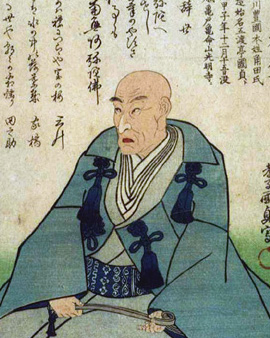Utagawa Kunisada was born in 1786 as Sumida Sh?gor? in Honjo, a district of Edo, now Tokyo, as the son of a ferryman who died shortly after Sumida's birth. The inherited ferry business ensured Sh?gor?'s existence regardless of his artistic career. Sh?gor?'s early sketches made an impression on the head of the Utagawa School: Utagawa Toyokuni (1769 - 1825). Around 1800 Sh?gor? was accepted into the Utagawa School by Toyokuni and was given an artist's name by him, which was partly composed of the name of the school and that of his master: Utagawa Kunisada (borrowed from Toyokuni).
With his color woodblock prints, which included large-format prints and book illustrations, Kunisada quickly became the most important artist of the Utagawa school. His first large-format print of 1807 remained an exception for two years. From 1809 onwards, he also produced the prints for which Kunisada became particularly famous: portraits of actors, often in Kabuki costume, and bijingas ("pictures of beautiful women"). Of Kunisada's approximately 20000 color woodblock prints (not counting illustrations for several hundred books), a full 60% are portraits of actors and 15% are bijingas. With his extensive work Kunisada is one of the most productive artists in history. At the same time, he was the trendsetter of his time and had a significant influence on other artists of the Utagawa school.
×





.jpg)
.jpg)
_-_(MeisterDrucke-308645).jpg)
_-_(MeisterDrucke-308645).jpg)
 - (MeisterDrucke-566091).jpg)
 - (MeisterDrucke-566091).jpg)
 - (MeisterDrucke-637464).jpg)
 - (MeisterDrucke-637464).jpg)
.jpg)
.jpg)
.jpg)
.jpg)
.jpg)
.jpg)
.jpg)
.jpg)
.jpg)
.jpg)
_Kunisada_-_Combat_des_lutteurs_de_sumo_Uzugafuchi_et_Washigahama_Estampe_de_Utagawa_Kunisad_-_(MeisterDrucke-962269).jpg)
_Kunisada_-_Combat_des_lutteurs_de_sumo_Uzugafuchi_et_Washigahama_Estampe_de_Utagawa_Kunisad_-_(MeisterDrucke-962269).jpg)
_Kunisada_-_Two_Women_in_a_Flower_Garden_by_Utagawa_Kunisada_woodcut_crepon_technique_-_(MeisterDrucke-1112446).jpg)
_Kunisada_-_Two_Women_in_a_Flower_Garden_by_Utagawa_Kunisada_woodcut_crepon_technique_-_(MeisterDrucke-1112446).jpg)
 - (MeisterDrucke-195551).jpg)
 - (MeisterDrucke-195551).jpg)
 - (MeisterDrucke-74018).jpg)
 - (MeisterDrucke-74018).jpg)
.jpg)
.jpg)
 - (MeisterDrucke-64347).jpg)
 - (MeisterDrucke-64347).jpg)
_Kunisada_-_Ukiyo-e_Print_of_an_Actor_Playing_a_Samurai_by_Kunisada_-_(MeisterDrucke-980074).jpg)
_Kunisada_-_Ukiyo-e_Print_of_an_Actor_Playing_a_Samurai_by_Kunisada_-_(MeisterDrucke-980074).jpg)
.jpg)
.jpg)
.jpg)
.jpg)
.jpg)
.jpg)
 - (MeisterDrucke-218713).jpg)
 - (MeisterDrucke-218713).jpg)
 - (MeisterDrucke-161785).jpg)
 - (MeisterDrucke-161785).jpg)
.jpg)
.jpg)
_Kunisada_-_Ukiyo-e_Print_of_an_Actor_in_a_Female_Role_by_Kunisada_-_(MeisterDrucke-1027409).jpg)
_Kunisada_-_Ukiyo-e_Print_of_an_Actor_in_a_Female_Role_by_Kunisada_-_(MeisterDrucke-1027409).jpg)
 - (MeisterDrucke-166952).jpg)
 - (MeisterDrucke-166952).jpg)
 - (MeisterDrucke-264670).jpg)
 - (MeisterDrucke-264670).jpg)
_Kunisada_-_Shiki_no_Nagame_Maru-ni-I_no_Toshi_Toshi_actor_scene_from_The_Four_Seasons_-_(MeisterDrucke-1117377).jpg)
_Kunisada_-_Shiki_no_Nagame_Maru-ni-I_no_Toshi_Toshi_actor_scene_from_The_Four_Seasons_-_(MeisterDrucke-1117377).jpg)
.jpg)
.jpg)
.jpg)
.jpg)
_-_(MeisterDrucke-210443).jpg)
_-_(MeisterDrucke-210443).jpg)
.jpg)
.jpg)
 early 19th-mid 19th century - (MeisterDrucke-190261).jpg)
 early 19th-mid 19th century - (MeisterDrucke-190261).jpg)
.jpg)
.jpg)
_(colour_woodblock_print)_-_(MeisterDrucke-1031205).jpg)
_(colour_woodblock_print)_-_(MeisterDrucke-1031205).jpg)
.jpg)
.jpg)
.jpg)
.jpg)
.jpg)
.jpg)
.jpg)
.jpg)
_Edo_period_c183_-_(MeisterDrucke-310019).jpg)
_Edo_period_c183_-_(MeisterDrucke-310019).jpg)
.jpg)
.jpg)
_(colour_woodblock_print)_-_(MeisterDrucke-37732).jpg)
_(colour_woodblock_print)_-_(MeisterDrucke-37732).jpg)
.jpg)
.jpg)
_-_(MeisterDrucke-37041).jpg)
_-_(MeisterDrucke-37041).jpg)
 - (MeisterDrucke-196403).jpg)
 - (MeisterDrucke-196403).jpg)
.jpg)
.jpg)
.jpg)
.jpg)
.jpg)
.jpg)
 (for companion print see 69775) - (MeisterDrucke-89630).jpg)
 (for companion print see 69775) - (MeisterDrucke-89630).jpg)
.jpg)
.jpg)
_(colour_woodblock_print)_-_(MeisterDrucke-1031196).jpg)
_(colour_woodblock_print)_-_(MeisterDrucke-1031196).jpg)
_Kunisada_-_Hour_of_tiger_seventh_hour_of_morning_Ca_1818_Ukiyo-e_art_print_by_Utagawa_Kunis_-_(MeisterDrucke-1101821).jpg)
_Kunisada_-_Hour_of_tiger_seventh_hour_of_morning_Ca_1818_Ukiyo-e_art_print_by_Utagawa_Kunis_-_(MeisterDrucke-1101821).jpg)
 - (MeisterDrucke-149078).jpg)
 - (MeisterDrucke-149078).jpg)
_Kunisada_-_Combat_de_lutteurs_de_sumo_Estampe_de_Utagawa_Kunisada_(1786-1865)_-_Sumo_Wrestl_-_(MeisterDrucke-1010835).jpg)
_Kunisada_-_Combat_de_lutteurs_de_sumo_Estampe_de_Utagawa_Kunisada_(1786-1865)_-_Sumo_Wrestl_-_(MeisterDrucke-1010835).jpg)
.jpg)
.jpg)
.jpg)
.jpg)
_Kunisada_-_Woman_with_Sumptuous_Dresses_by_Utagawa_Kunisada_-_(MeisterDrucke-1120017).jpg)
_Kunisada_-_Woman_with_Sumptuous_Dresses_by_Utagawa_Kunisada_-_(MeisterDrucke-1120017).jpg)
.jpg)
.jpg)
.jpg)
.jpg)
_Kunisada_-_Shiki_no_Nagame_Maru-ni-I_no_Toshi_Toshi_actor_scene_from_The_Four_Seasons_-_(MeisterDrucke-1110082).jpg)
_Kunisada_-_Shiki_no_Nagame_Maru-ni-I_no_Toshi_Toshi_actor_scene_from_The_Four_Seasons_-_(MeisterDrucke-1110082).jpg)
 - (MeisterDrucke-155627).jpg)
 - (MeisterDrucke-155627).jpg)
.jpg)
.jpg)
 1830-1844 - (MeisterDrucke-246221).jpg)
 1830-1844 - (MeisterDrucke-246221).jpg)
 - (MeisterDrucke-162058).jpg)
 - (MeisterDrucke-162058).jpg)
.jpg)
.jpg)
.jpg)
.jpg)
 - (MeisterDrucke-196226).jpg)
 - (MeisterDrucke-196226).jpg)
_Kunisada_-_Combat_des_lutteurs_sumo_Shitaky_Beya_et_Hidenoyama_Estampe_de_Utagawa_Kunisada_-_(MeisterDrucke-1028833).jpg)
_Kunisada_-_Combat_des_lutteurs_sumo_Shitaky_Beya_et_Hidenoyama_Estampe_de_Utagawa_Kunisada_-_(MeisterDrucke-1028833).jpg)
 - (MeisterDrucke-178600).jpg)
 - (MeisterDrucke-178600).jpg)
.jpg)
.jpg)
.jpg)
.jpg)
.jpg)
.jpg)
_Kunisada_-_Detail_of_Character_Five_from_Five_Characters_from_a_Play_by_Toyokuni_(see_also_-_(MeisterDrucke-1114189).jpg)
_Kunisada_-_Detail_of_Character_Five_from_Five_Characters_from_a_Play_by_Toyokuni_(see_also_-_(MeisterDrucke-1114189).jpg)
_Kunisada_-_Shiki_no_Nagame_Maru-ni-I_no_Toshi_Toshi_actor_scene_from_The_Four_Seasons_-_(MeisterDrucke-1117451).jpg)
_Kunisada_-_Shiki_no_Nagame_Maru-ni-I_no_Toshi_Toshi_actor_scene_from_The_Four_Seasons_-_(MeisterDrucke-1117451).jpg)
.jpg)
.jpg)
.jpg)
.jpg)
.jpg)
.jpg)
_(colour_woodblock_print)_-_(MeisterDrucke-1011349).jpg)
_(colour_woodblock_print)_-_(MeisterDrucke-1011349).jpg)
.jpg)
.jpg)
.jpg)
.jpg)
_(colour_woodblock_print)_-_(MeisterDrucke-984594).jpg)
_(colour_woodblock_print)_-_(MeisterDrucke-984594).jpg)
.jpg)
.jpg)
.jpg)
.jpg)
.jpg)
.jpg)
_Kunisada_-_Portrait_du_lutteur_de_sumo_Goyogi_Kumoemon_Estampe_de_Utagawa_Kunisada_(1786-18_-_(MeisterDrucke-1028829).jpg)
_Kunisada_-_Portrait_du_lutteur_de_sumo_Goyogi_Kumoemon_Estampe_de_Utagawa_Kunisada_(1786-18_-_(MeisterDrucke-1028829).jpg)
.jpg)
.jpg)
.jpg)
.jpg)
.jpg)
.jpg)
 1843-1847 - (MeisterDrucke-152447).jpg)
 1843-1847 - (MeisterDrucke-152447).jpg)
.jpg)
.jpg)
.jpg)
.jpg)
_pose_-_(MeisterDrucke-1347666).jpg)
_pose_-_(MeisterDrucke-1347666).jpg)
.jpg)
.jpg)
.jpg)
.jpg)
.jpg)
.jpg)
.jpg)
.jpg)
 mid 19th cen - (MeisterDrucke-637453).jpg)
 mid 19th cen - (MeisterDrucke-637453).jpg)
 - (MeisterDrucke-218133).jpg)
 - (MeisterDrucke-218133).jpg)
_(woodblock_print)_-_(MeisterDrucke-906246).jpg)
_(woodblock_print)_-_(MeisterDrucke-906246).jpg)
 (colour woodblock print) - (MeisterDrucke-212744).jpg)
 (colour woodblock print) - (MeisterDrucke-212744).jpg)
.jpg)
.jpg)
.jpg)
.jpg)






